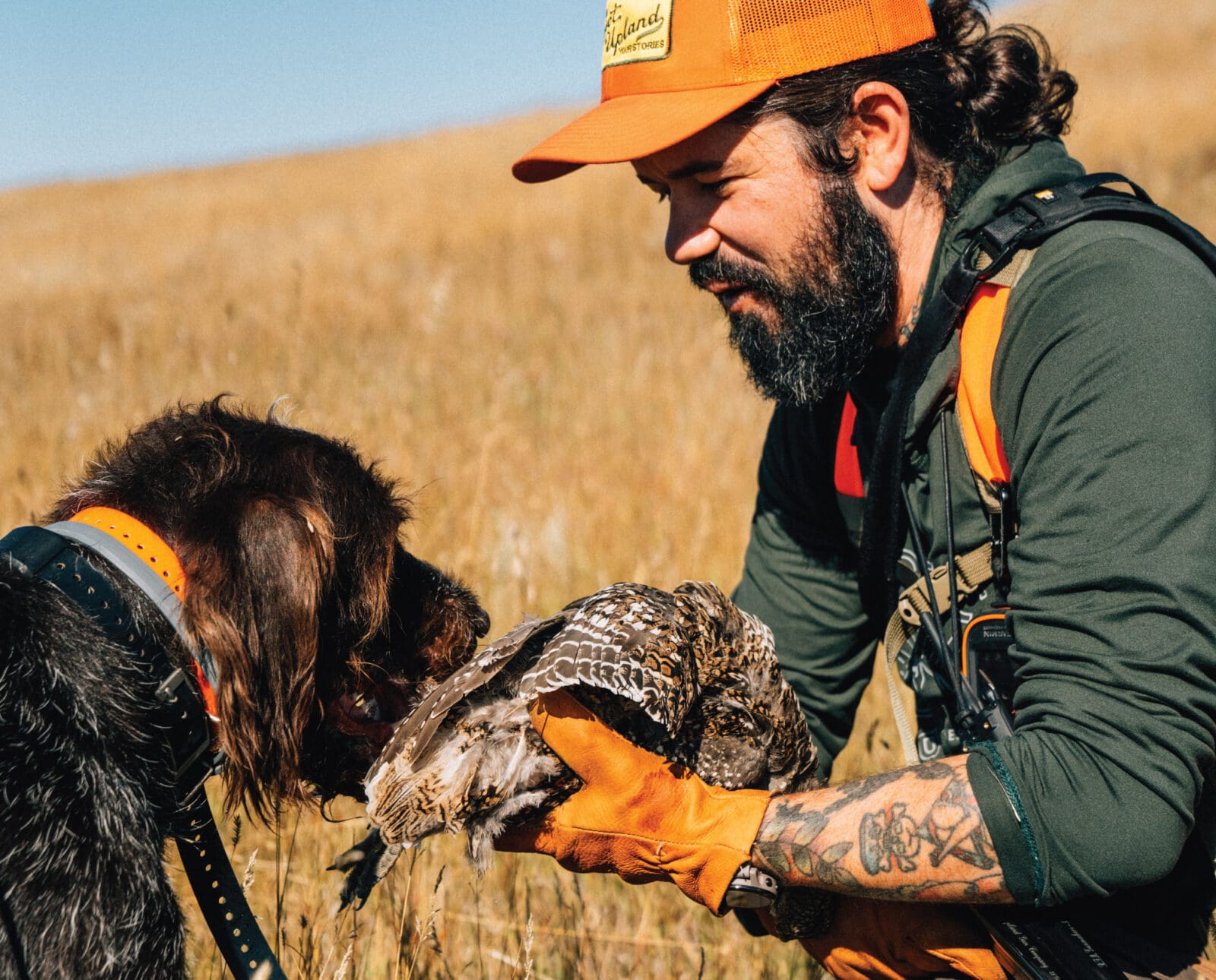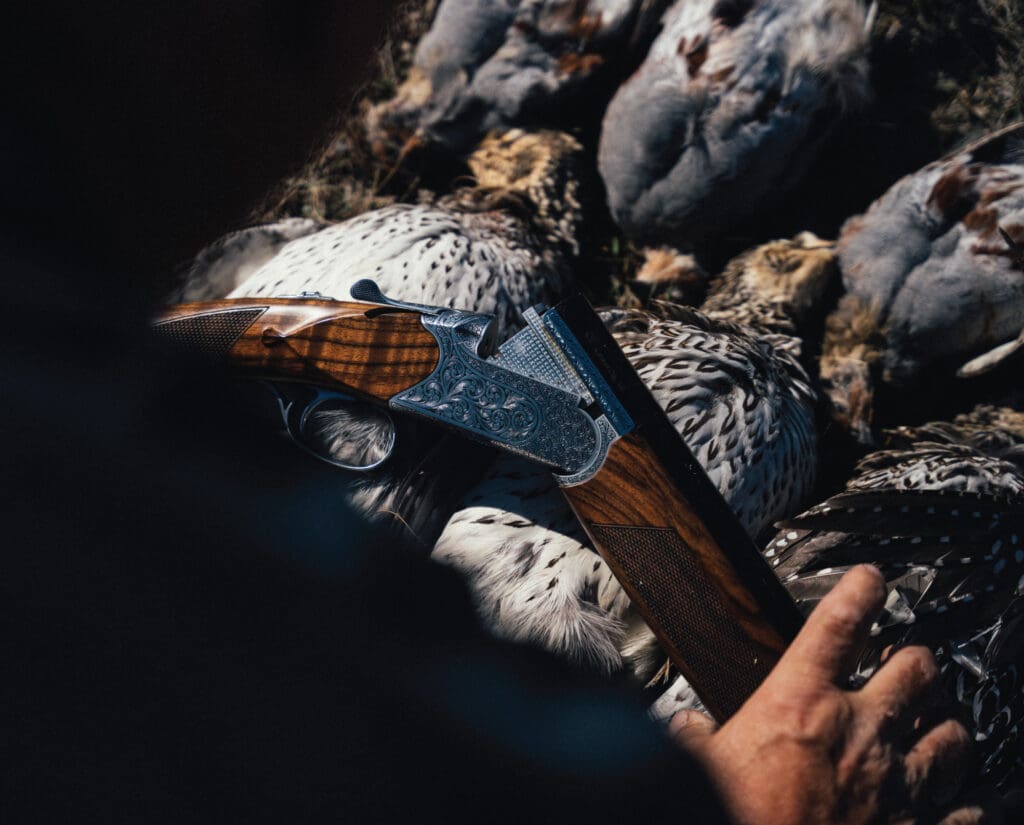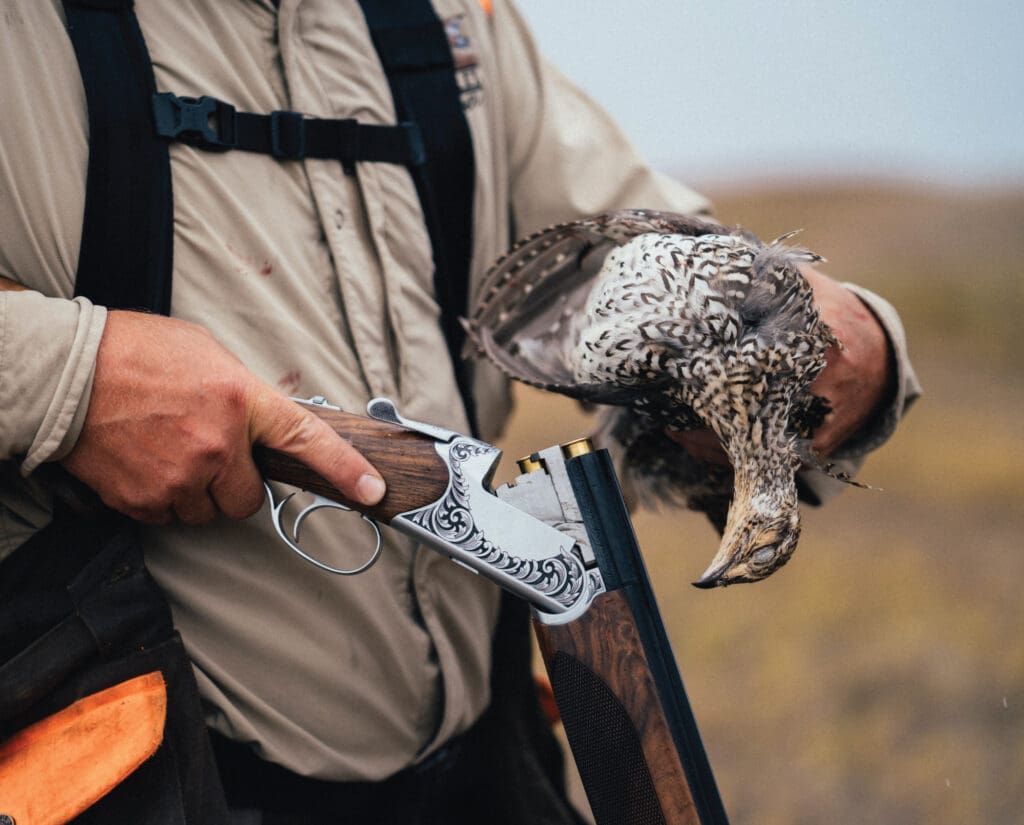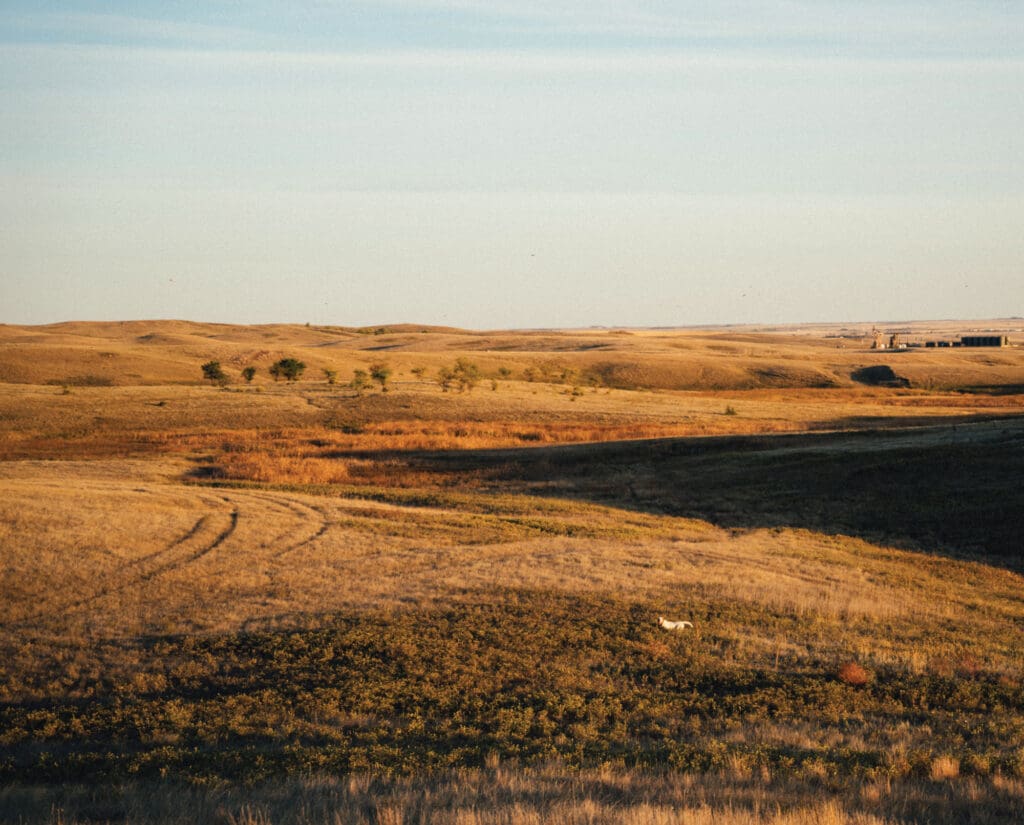Home » Grouse Species » Sharp-tailed Grouse Hunting » Complete Guide to Sharp-tailed Grouse Hunting
Complete Guide to Sharp-tailed Grouse Hunting

Frank Loncarich has been a wildlife biologist for over 20…
Raised in the upland bird mecca of Kansas, the passion…
Discover the intricacies of sharptail grouse habitat, effective hunting techniques, and optimizing dog performance for a successful hunt.
Sharp-tailed grouse, often known as sharpies, sharptails, or sharp-tails, are iconic birds of North America’s prairie landscape. Their spring mating ritual takes place on breeding sites called leks. At these sites, sharpies put on an amazing display of calling and dancing called booming. Those same general areas are where broods are raised, and early fall activities occur.
Listen to more articles on Apple | Google | Spotify | Audible
Their survival requires large tracts of unfragmented, treeless landscapes. This is a trait carried into modern times; these birds evolved in what once was millions of acres of ideal grassland habitat that existed before European settlement. Hunting sharp-tails can take hunters to some of the most beautiful landscapes on the continent. Here is a guide to help you get started on a new adventure.
Where to Find Sharp-tailed Grouse
Sharpies dot the prairie landscapes across several north-central and western states, Alaska, and many Canadian territories. Western Nebraska, North Dakota, South Dakota, Wyoming, and Montana harbor the highest populations in the lower 48 states. Smaller, localized, but huntable populations can be found in a few other states, including Minnesota, Michigan, Colorado, Utah, and Idaho.
Vast treeless grassland landscapes provide these amazing birds with ideal nesting and brood rearing habitat. Native grasses provide the perfect substrate for building a nest bowl. The native forbs (broadleaf weeds) attract insects that are necessary for chick growth. Those same insects are also a preferred food for adult birds well into the fall until freezing temperatures arrive. There are a few states listed above where sharp-tails reside in a different type of habitat called barrens. This is a grassland-centered cover type mixed with scattered brush or small trees. Although open grasslands are the breeding grounds for these prairie grouse, there are plenty of opportunities to hunt them in cropland as well. More to come on hunting strategies later.

Seasons and Bag Limits for Sharp-tailed Grouse
Season timing and bag limits are important considerations when planning a sharp-tail hunting adventure. Many states have seasons that open in early September. Early season outings can provide bird contacts with smaller family groups and uneducated birds, resulting in a wonderful opportunity for quality hunting dog work. On the flip side, these early outings often have excessively warm temperatures, making a full-day hunt unlikely. Most sharptail seasons extend well into the winter. Late-season hunters often make contact with larger groups of birds. These large groups have a lot of watchful eyes in the flock, making getting within gun range much more difficult.
Bag limits and possession limits can’t be overlooked. A bag limit represents the number of birds a hunter can harvest during a single day. Bag limits vary across states, but most are between two to four birds. Most hunters know the bag limit where they are hunting, but the possession limit is also important to know. The possession limit is the maximum number of birds you can have from all the days you have hunted, including the current day of your hunt. Most states have a possession limit that is three or four times the daily bag limit. During a long trip or a successful hunt, reaching the state’s possession limit is possible. If this happens, you have a couple of options. You can eat some birds to reduce the number of birds in your possession or donate some birds to another person. Most states require the hunter’s name, license number, date, species, and number of birds being donated.
Keeping birds labeled and identifiable during the remainder of the hunt is something else to consider. Most states require keeping at least one wing attached to the dressed bird so wildlife officers can properly identify the bird species. Additionally, bags of birds should always include the hunter’s name, license number, and harvest date. Keep the birds bagged separately for all the hunters in the party so officers know how many birds each hunter has toward their possession limit.
Some states have various units with different seasons, bag limits, and possession limits. Regardless of your destination, it is important to always check the specific regulations, as seasons and limits can change annually.
Shotguns, Chokes, and Shot Size Selection Recommendations for Sharp-tailed Grouse Hunting
Twenty- and twelve-gauge shotguns are by far the most preferred tool when traveling to sharp-tail habitat. However, a proficient shooter can find success even with a 28-gauge. Sharp-tail hunts can result in 10+ miles of boot leather on the ground in a single day. Whatever firearm you prefer, carrying something on the lighter side, preferably less than seven pounds, can make those long days more tolerable.
As previously mentioned, early season outings often yield juvenile or unpressured birds, resulting in closer shots. Due to this, improved cylinder or modified shotgun chokes are an ideal choice. Any quality pheasant load will suffice, with preferred shot sizes of 4, 5, or 6s. I tend to select 6s for sharptails because they are not a tough bird to bring down, and #6 shot has a higher pellet count than 4s or 5s. As the season progresses, birds become more wary and form larger groups, making them more likely to flush at longer ranges. Using a modified or even a full choke isn’t out of the question during the late season.

Sharptail Grouse Hunting Strategies
Although most states have one continuous sharptail season, it starts early enough in the fall that the birds often behave completely differently in the early season versus the late season. Likewise, they will also shift their preferred habitat location as the season progresses, depending on available food resources and weather conditions.
In the early season, birds are typically still in smaller family groups. They tend to stay near areas where they were raised, which means out in the grasslands. In early fall, sharpies eat insects, particularly grasshoppers, various berries, and green vegetation. Insects and grasshoppers utilize forbs, so finding areas with a diverse array of plants usually harbors the most sharp-tail food and, thus, the most birds.
Vegetation height is also critical to finding birds. Sharp-tails, like other prairie grouse, want to see danger approaching. They prefer vegetation 12-18 inches tall. This provides enough height to conceal them if an aerial predator flies over but is short enough to see long distances. When hunting vast expanses of rolling hills, ridge tops tend to have shorter vegetation, so focus efforts along the tops and sides of ridges.
Additionally, the landscapes these birds utilize are often comprised of low-quality, sandy soil. This soil type lends itself to centuries of wind erosion, which has resulted in bowls and blowouts on some of the side hills. These blowouts usually have a high diversity of forbs and occasional brush pockets. This makes the ideal location for birds to loaf and feed. When hunting ridges, try to avoid silhouetting yourself. Walk just off one side of the ridge and wrap the tops of hills to approach blowouts in a stealthy fashion.
Tall, dense vegetation often found in Conservation Reserve Program (CRP) fields is typically not the ticket, especially during the early season. Unless you’re hunting the more sparse stands in Montana or CRP fields planted with smooth brome, which are often found in portions of the Dakotas, you probably won’t find birds there. Likewise, cattail sloughs and other dense pheasant habitat is not worth hunting. However, the shin-high grasslands become unusable for sharp-tails after the snow flies. They are forced to transition into CRP fields and other similar cover types, so late-season birds will often be found in these taller, denser habitats.
When cropland is near grasslands, birds often shift from their breeding and brooding habitat and move into the crop fields, even during the early season. Birds can be found along the edges but will even occupy the interior of a crop field, especially in unharvested fields. Sunflower fields are highly attractive as they usually have a robust population of grasshoppers and sunflower seeds, providing excellent food options. Corn fields will also hold their fair share of sharpies throughout the season.
Getting within gun range of birds hanging out in the center of crop fields is nearly impossible. However, hunting the margins of those fields can produce some shot opportunities. The edges frequently have grass or weeds that will serve as loafing cover between feeding sessions. Check the waterways or sloughs that meander through crop fields, too. I stand behind my previous statement about not hunting cattail sloughs during the early season, but the edges of those sloughs, if they cut through a crop field, are a different story. There is always a transition zone between the cattails and crops with diverse vegetation. This is where the birds will be found. Waterways that have the proper vegetation height can also provide an ideal opportunity. If birds utilize the interior of crop fields, they typically roost in some type of herbaceous vegetation nearby. If the roost location can be identified, there is an opportunity to walk up some birds at first light before they head out to the crop field for the day.
Although treeless grasslands are the iconic image of sharp-tail habitat most hunters envision, they will sometimes occupy fields dominated by herbaceous vegetation bisected with young conifer tree rows or shrub rows. They will utilize the woody cover as overhead protection from aerial predators, often loafing all afternoon in these locations. Thickets of snowberry, whether part of a planted shrub row or naturally occurring within a grassland, should never be overlooked. These areas are a favorite midday loafing spot. Sharpies will also use rows of conifers during snow events. I have experienced some stellar hunts in these types of locations in North Dakota. Birds tend to hold tighter when hunkered down in woody cover, allowing solid points and close flushes.

Dogs, Sharp-tailed Grouse Behavior, and the Flush
As with any upland bird hunting, keeping the dogs working into the wind, or, at a minimum, a crosswind, is ideal. Both flushers and pointing dogs can effectively corral these skittish prairie birds. Young birds or the occasional single will sometimes allow a pointing dog to pin them down within a few feet. However, sharpies usually will not hold for a dog that crowds too tight. High-headed points are ideal, signifying birds are well out front, sometimes over 30 yards away. These types of points can also indicate the presence of a larger group of birds putting off a wide scent cone.
The wind speed can play a critical role in bird behavior. During windy conditions, sharp-tails lose the ability to hear approaching danger, so they become more wary. Long flushes are the norm. These windy days are the ideal situation to wrap around the peak of a hill and catch birds on the lee side, loafing in a blowout. Wind also reduces a hunter’s ability to hear birds flush, so it’s important to constantly scan left and right as you stroll through the grasslands.
I have always considered a sharptail flush to be quite unique. They seem to leap into flight silently. But, once they are in flight, a very distinct “giggle” can be heard. Another common characteristic is that sharpies are “popcorn” flushers. If some birds start flushing out of gun range, hustling toward the flush site will often result in a shot opportunity of a late flusher or two.
Sharp-tails offer hunters the opportunity to explore some of the most desolate, wide-open spaces in the uplands. Long seasons give hunters the option to hunt smaller family groups during the early season or chase large flocks during the winter. If you have never pursued these regal birds, do some research and plan a trip this season. You won’t regret your time in sharp-tail country.
Frank Loncarich has been a wildlife biologist for over 20 years, specializing in bobwhite and grassland management. He is also a Habitat Consultant for Land and Legacy.
Raised in the upland bird mecca of Kansas, the passion for upland birds was born at a young age for Kyle Hedges. He has now spent over 25 years managing upland game habitat on public lands in Kansas and Missouri for State Conservation Agencies. He also works as a Habitat Consultant for Land and Legacy, assisting landowners across the country with improving their properties.





I love the information but the audio version of this feels so much like A.I. that it’s hard to listen to. Otherwise great, but it would be so much better without the robotic pronunciation of some words.
Just my 2 cents that might be irrelevant to some.